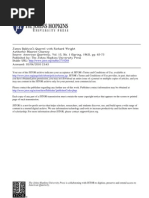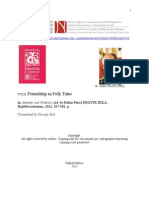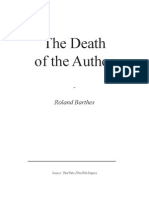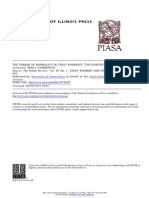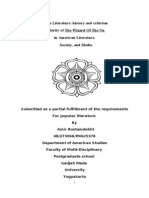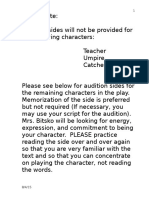Fairy Tale Lecture II
Fairy Tale Lecture II
Uploaded by
sintamelya7Copyright:
Available Formats
Fairy Tale Lecture II
Fairy Tale Lecture II
Uploaded by
sintamelya7Copyright
Available Formats
Share this document
Did you find this document useful?
Is this content inappropriate?
Copyright:
Available Formats
Fairy Tale Lecture II
Fairy Tale Lecture II
Uploaded by
sintamelya7Copyright:
Available Formats
The fairy tale as such emerged during the sixteenth and seventeenth century as a literary genre after a long
incubation period that goes back long before the origin of books probably as far as Mesolithic period and perhaps as early as the Paleolithic, between 10,00 and 40,000 years ago. The traditional oral cultures that created the oral antecedent of the fairy tale used them for ritualistic purposes. The emphasis we find in certain tails upon the magical efficacy of repetition suggests the worldview described by Mircea Eliade in his discourse on traditional society. About repetition, writes Eliade, traditional humanity acknowledges no act which has not been previously posited and lived by someone else, some other being who was not a man. What he does has been done before. His life is the ceaseless repetition of gestures initiated by others. . . . The gesture acquires meaning, reality, solely to the extent to which it repeats a primordial act. The unrivaled importance of repetition is seared into the fairy tale, where in tales like The Talking Eggs, The Drum, The Flute, or Diamonds and Toads, the ability to follow a meaningless set of directions confers magical power upon the initiate, or lends the ritual object magical properties the protagonist is able to control. Intervening between the archaic words or mantra we can never recover and the fairy tale was something folklorists call the wonder folktale, or magic tale. Jack Zipes claims that the wonder tale existed for thousands of years, but perhaps this is a bit murky, since we have no records of wonder tales dating from the Neolithic or Bronze Age cultures, in whose great Mid-Eastern cities writing first developed, not as a means of persevering stories, but to keep business accounts. Perhaps the wonder tale was a late decay product of the breakdown in traditional societies, in which the rituals of ceaseless repetition that were originally meant to abolish the continual flow of profane time became in some sense nostalgic narratives; and the gods, ancestors or other exemplary models whose acts had established the world, slowly became the oppressed, suffering, or merely disadvantaged protagonists. Nevertheless, whenever it emerged, under whatever political circumstances and for whatever purpose, the wonder tale generally focused on miraculous transformations that overcame the disadvantages of the hero and enabled him or her to prevail over perilous circumstances and/or menacing superhuman adversaries and succeed in life. The crucial factor that midwived the fairy tale from the wonder folktale was writing: as more and more wonder tales were written down in the 14 th-17th centuries, they constituted the genre of the fairy taleor a term Jack Zipes uses interchangeably with fairy tale, the literary fairy tale. The literary fairy tale laced the old wonder tale with new elements yet it retained the salient emphasis upon the cursed, disadvantaged, ostracized or marginalized individuala character whose condition we might consider in relationship to the scapegoatand, more significantly, it retain an emphasis upon magical transformation and a sense of wonderthe same sense which we associate with childrenand have since the late eighteenth century.. That magic can overcome all forms of adversity remains a distinguishing mark of the fairy tale todayalthough
sometimes it is the failure of magic, and the hopelessness of our expectations, with which we are confronted. If it was possible in the 17 th century to say that there are as many fairy tales as there are tellers, we may now say there are as many definitions of the fairy tale as there are fairy tale scholars. However, the definition that seems most to have acquired near consensus among folklorists is the one posited by none other than Jack Zipes, which synthesizes the work of an earlier 20th century folklorists, including Jens Tismar. "In his first short monograph, [Jens] Tismar set down the principles for a definition of the literary fairy as genre: 1. it distinguishes itself from the oral folk tale in so far as it is written by a single identifiable author; 2. it is thus synthetic, artificial, and elaborate in comparison to the indigenous formation of the folk tale that emanates from communities and tends to be simple and anonymous; the differences between the literary fairy tale and the oral folk tale do not imply that one genre is better than the other; in fact, the literary fairy tale is not an independent genre but can only be understood and defined by its relationship to the oral tales as well as to the legend, novella, novel, and other literary fairy tales that it uses, adapts, and remodels during the narrative conception of the author." The redirection of a traditional story by a single writer is perhaps the most difficult aspect of the fairy tale definition, because we are used to conceiving of them as ancient and traditional works: our cultural patrimony. Who wrote Cinderella? Who wrote Little Red Riding Hood? Well, studying the collections of fairy tales transcribed from the folk, we can see how they are authored, even if the collector-transcriber could not. The fairy tales of Grimm, for instance, represent the work of individuals rather than a community, culture or nationstate. Jacob Grimm was persuaded that the tales were remnants of an ancient German culture; but, in order to restore the contemporary tale to its original state, he communicated anthropological data to his brother, Wilhelm, who then smoothed the language of the tales he collected. He artificially created a self-consciously archaic prose, one that, while it came to seem the uninflected oracular language of the ancient tale, really represented the best guess of an educated German citizen of the 19th century. Zipes describes this kind of authorship with scholarly finesse: the definition . . . of the fairy tale, he writes, depends on the manner in which a narrator/author arranges known functions of a tale aesthetically and ideologically to induce wonder and then transmits the tale as a whole. Vladimir Propp, another scholar whose work is foundational in 20 th century fairy tale studies, provides a list of other defining characteristics which the fairy tale derived from the wonder tale, in his The Morphology of the Folk Tale (1928). While these elements are
not all present in every fairy tale, the represent a pattern or grammar that can help us to recognize the fairy tale and discuss distinctions among tales. Most plots will follow a basic pattern which begins as the protagonist is confronted by a taboo which he or she violates in some way; which leads to banishment or to the assignment of a task or tasks. In the story of Cupid and Psyche, for example, first recorded in the second century, after violating the interdiction against gazing at Cupid, her immortal lover, Psyche is assigned a set of tasks by Cupids vengeful mother, Aphrodite: this includes dividing a pile of mixed grains into tidy piles (in which, having heard Le Guins fairy tale you will be interested to learn, Psyche is assisted by friendly ants), gathering wool from a flock of golden sheep (which she is again luckily assisted in accomplishing), filling a bucket of water from the River Styx, and, ultimately, fetching a box of beauty from Queen Persephone, the dark mistress of the Underworld. Psyche has help with all of the tasksin fact, she is strikingly different from the heroic youngest daughter of Gifts, and with each task her thoughts tend immediately to despair and suicide: Psyches responses are uncharacteristic of protagonists in fairy tales, but the divine or supernatural assistance she receives is very typical. Zipes notes that protagonists will have encounters with all sorts of characters: a deceitful villain; a mysterious individual or creature, who gives the protagonist gifts; three different animals or creatures who are helped by the protagonist and promise to repay him or her; or three different animals or creatures who offer gifts to help the protagonist, who is in trouble. The gifts are often magical agents, which bring about miraculous change. Eventually, and you can read this in Zipess introduction on page roman numeral seventeen, The inimical forces are vanquished [and] the success of the protagonist usually leads to marriage and wealth, as, indeed, it does in the tale of Cupid and Psyche, as well as the tale of the four daughters. The conclusion in marriage is typical of Greek comedy as it is of Old and New Roman and all comedy through Shakespeare, so we can say that the fairy tale suggests affinities with the conventions of Comedy rather than Tragedy. Again, while these elements tend to be present in fairy tales, they are not always so, but the one constant in the structure is that of transformation or miraculous transformation. The transitioning of wonder tale to fairy tale truly seems to gain momentum in the early modern period: While the growth of towns, religious conflicts, and peasant uprisings [against Feudalism] affected both the subject matter and the use of the [wonder] tales, the introduction of printing from movable type, was the single most important factor. As more and more [tales] were printed in the fifteenth, sixteenth, and seventeenth centuries, they began to constitute . . . the literary fairy tale, which gradually took on its own conventions (rooted in its oral antecedents) that appealed to a smaller and more aristocratic reading public. It was first in Giovan Francesco Straparolas Piacevoli notti (translated as The Facetious Nights and The Delectable Nights, 1550-1553) and then in Giambattista Basiles Lo cunto de li cunti (better known as The Pentamerone, 1634-36)
and Pompeo Sarnellis Posilecheata (1684) that wonder tales were fully adapted and transcribed to amuse educated readers. . . . (JZ) Despite the ingenuity of Italian authors, because they formed no social network to support the spread of this new literature, it was in France that the literary fairy tale truly took form. By the mid-seventeenth century, aristocratic women had established literary salons and were promoting a type of parlor game that incorporated the use of folk motifs and narrative conventions. The participants were expected to show their wit and expressiveness by inventing wondrous tales (contes de fees) that dealt with such subjects as tender love, courtship, proper comportment, and the use of power. As these games grew increasingly popular in Paris, players often wrote down or rehearsed the fairy tales at home so that they might appear prcieux (unique) or as natural as possible when asked to recite. By 1690, authors such as Marie-Catherine dAulnoy and Catherine Bernard began first to incorporate fairy tales into their novels and then to publish entire collections of fairy tales. The most famous writer from that era is Charles Perrault, who in 1697 published his collection Histoire ou contes du temps pass (Stories or Tales of Times Past), subtitled and thence translated into English in 1729 as Tales from Mother Goose. (JZ) Perrault designates the tales as having been told by governesses and grandmothers to their children (MT). These aristocratic and bourgeois women and men performed their tales in the salons and published them so that they might demonstrate their individuality, their eloquence, and their wit or espirit. The tales were intended not just to amuse the listeners but also to establish the conventions of a discourse on manners and civilit, with an implicit code that corresponded to the standards of propriety. The resulting tales differed radically in content and style from their originals, whether those had been heard from nurses, governesses, or servants or had been read in books such as those by Straparola, Basile, and other Italian writers. When these tales were adapted from the salon to the page they were adapted even more, for the author could employ even more florid language and invent even more extraordinary events. In addition, the literary fairy tales had a serious undertone. Many, particularly those by women, criticize the policies of Louis XIV, whose wars and conversion to orthodox Catholicism had ended Frances dominance as the ruling power in Europe. The utopian projections of magnificent courtly life, where a just ruler guarantees peace and happiness for his subjects, reveal the discontent of the writers and their desire to change French society during the latter days of the Sun Kings rule . . .. (JZ) It is useful to keep in mind the subversive aspect of seventeenth century fairy tales because we see it again and again in later tales, as we know from our reading in Block and McKinley, among others. It is important to remember, also, that these fairy tales were written explicitly for adults, even those by Perraulta point Zipes stresses so that we do not suppose Charles Perrault was in any sense a childrens author. However, while he may not have intended his tales to appeal to children, we know that they were read by childrenor at least young adults.
During the late seventeenth and early eighteenth centuries, fairy tales were printed in a series of chapbooks called the Bibliothque bleue that were sold by peddlers (colporteurs) throughout France, central Europe and England[where the sellers were called chapmen.] In this format the tales were often translated and shortened, and their language simplified. (JZ) It was through these chapbooks that an increasingly educated population of children became familiar with fairy tales and the tales, themselves, could begin to claim a nostalgia appeal and the authority of tradition. (MJ) Beginning in the mid eighteenth century, despite the hostility of puritan censors, English authors began to incorporate some fairy tales in volumes intended for children. The most notable examples are found in Sarah Fieldings The Governess: or, Little Female Academy (1749) and in Magasin des enfans (translated in 1757 as The Young Misses Magazine) by Jeanne-Marie Leprince de Beaumont. Both Fielding and Leprince de Beaumont use a larger frame tale of schooling to hold stories that illustrate lessons of morals and manners. Often such embedded tales were later published separately. (JZ) During the eighteenth century, the notion that fairy tales could be written and published for children emerged against the usual hidebound conservative resistance. Although a specific childrens culture was developing, in North America and much of Europe, fairy tales were generally considered to be inappropriate for children, and dangerous for promoting a sense of wonder based in superstitions, magic, and fantasy. (JZ) A class division began to act upon childrens literature: while most poor childrenthe modern peasantrycontinued to hear oral wonder tales, children of the upper and educated classes were urged toward reading material that would [help] them live rationally, in accordance with Christian ideas and foster proper manners. The fairy tales of Fnelon, Sarah Fielding, Mme Leprince de Beaumont, and other traditional writers of the eighteenth century gradually wrested approval from the censorious only because they were overly didactic and moralistic, and sustained patriarchal notions of power. Though pleasurable to read, the literary fairy tale for children was clearly intended to instruct. Amusement was secondary, (JZ). although this would change dramatically within a relatively brief period of time. The nineteenth century saw several major changes to the nature, orientation and reception of the fairy tale. E.T.A. Hoffman and other German Romantics utilized the adult fairy tale to contain sophisticated dialogues about social and political issues, broadening the critical component developed by the French salon authors. Fairy tales were published for children during the early years of the century in inexpensive illustrated toybook form, much like the chapbook form of previous decades, although these were regarded with mixed feelings; some adults continued to regard them as not healthy for the development of childrens minds. (JZ) The cultural struggle over the fairy tale in Europe is nicely exemplified by the efforts of Wilhelm Grimm, who, began in 1819 to revise their collected tales, Kinderun Hausmrchen (Childrens and Household tales, first published in 1812 and 1815), to make them more suitable for children: he added Christian sentiments and removed
erotic, cruel, or bawdy passages. But, withal the sanitizing of the tales, the fantastic and wondrous elements remained; (JZ) and, therefore the publication in England of Edgar Taylors translation of the Grimms tales under the title German Popular Stories (1832) signaled the determination of those who perceived underlying affinities between the wonder of childhood and the magic of the fairy tale. This new liberalism or progressivism can be traced in part to the ideas of philosophers and educators, such as the Swiss-born French philosopher and political theorist JeanJacques Rousseau, the Swiss educational reformer Johann Heinrich Pestalozzi, and the German educator Friedrich Froebel, the inventor of the Kinder-Garten, which emphasized liberty and play in learning. The playful elements of the fairy tale were thus accorded a pedagogical and conceptual value they had previously lacked. Amusement was crucial for the well being of the mind of the child as a child. With the Industrial Revolution and the explosive growth of the middle classes between 1830 and 1900 the fairy tale for children came into its own. From 1835 onwards Hans Christian Andersen began publishing his tales, which won great acclaim throughout the world; almost all were immediately translated into English and published in England and America. (JZ) [and] during the first half of the nineteenth century, the majority of fairy tale writers for childrenCatherine Sinclair, George Cruikshank, and Alfred Crowquill, [for example], emphasized lessons that were in keeping with the Protestant ethic. These were industriousness, honesty, cleanliness, diligence, virtuousness-and male supremacy. (JZ) Im skipping over the first part of the nineteenth century, but you can read these notes, if youd like in E-Companion. By 1830, most educators as well as the clergy had come to believe that children needed fantasy in their lives. . . . It was preferred, of course, the imaginative literature would serve a didactic goal, and tales of the Grimm Brothers other rehabilitated folktales were valued both for their elements of fantasy and because they seemed to lend traditional support to Protestant acculturation. However, as we know, of course, this began to change dramatically after the middle of the century. Fairy tale writers began to make dramatic demands upon the conceptual abilities of childrenor, to say this is another way, fairy tale writers began to credit children with a greater capacity for sophisticated thought than had previously been considered; and they began to construct a notion of childhood that was compatible with leaps of intuition, sophisticated humor, and a fundamental sense of what was real or true. Jack Zipes writes that authors began to turn the [fairy tale] upside down and inside out, to question the traditional value system, and to provide new endingsendings that appeared to contradict the notion of wonder and transformation that had been so dominant in the wonder folktales. These authors, who heralded what has been called the Golden Age of Childrens Literature, included William Makepeace Thackeray (The Rose and the Ring, 1855), George MacDonald (The Light Princess, 1863), Lewis Carroll (Alices Adventures in Wonderland, 1865), Jean Ingelow (Mopsa the Fairy, 1869), Juliana Ewing (Old-Fashioned Fairy Tales,
1822), Andrew Lang (Princess Nobody, 1884), Oscar Wilde (The Happy Prince and Other Tales 1888), Kenneth Grahame (The Reluctant Dragon, 1898), Edith Nesbit (The Last of the Dragons, 1899). These, and other writers began to experiment with the fairy tale in ways that encouraged young readers not only to question their expectations of literary experience, but to question the world around them, as well. They did not offer prescriptions on good housekeeping and clean living. Instead, they suggested that conventional living could be stifling, boring, overly safe and predictable-and hinted alternatives were at hand. (JZ) If, as Steven Greenblatt as said, the work of art is not the passive surface upon which historical experience leaves its mark, but one of the creative agents in the fashioning and refashioning of experience, then it is here that the fairy tale begins to recast the mental lives of children in ways that we might call liberating. Perhaps the most important fairy tale of this period, and certainly the most influential, was The Wizard of Oz (1900), a work modeled after the late nineteenth century European model. In his fourteen Oz books, Baum created an American fairy-tale saga; its use of political and cultural commentary profoundly influenced the later direction taken by the genre, as can be seen in the works of twentieth-century authors in England (e.g., J.R.R. Tolkien and C.S. Lewis) and Germany (e.g. Michael Ende) as well as the United States (e.g. T.H. White). The Anglo-Indian novelist and essayist Salman Rushdie, who has himself written a fable for children (Haroun and the Sea of Stories, 1990) acknowledges a long fascination with The Wizard of Oz a work that continues to shape books and films today. (JZ) [Sidebar comment: Joel Chaston, a Wizard of Oz scholar, has called the popular 1939 movie the most influential movie of all time.] At the same time that Baum was making history in America, J.M. Barrie helped [popularize] the fairy tale in England with Peter Pan, or The Boy Who Wouldnt Grow Up (1904), based on characters who first appeared in his novel, The Little White Bird 1902). . . . during the London premiere of Peter Pan, the largely adult audience shouted Yes! when Peter Pan asked whether they believed in fairies. It was a Yes heard again the following year in New York, and it still echoes wherever and whenever versions appear on stage or screen. Perhaps more than Baums Dorothy, Peter Pan has captured the imagination of young and old audiences throughout the world. (JZ) By the beginning of the twentieth century, in Europe and America the functions of the fairy tale had shifted and expanded. The genre had become fully institutionalized: that is, its production, distribution, and reception gained full acceptance within the public sphere as it played a role in forming and maintaining a given societys cultural heritage. Such institutionalization both preserves the genre and involves it in socializing and acculturating readers. Thus, in every specific time and place the genre is defined by the interaction of writer publisher, and audience. The aesthetics of each fairy tale will depend on how and why an individual writer chooses to intervene in an ongoing discourse. (JZ)
Beginning with the early twentieth century, whose turning was marked by the enormously influential Wizard of Oz books by L. Frank Baum, Zipes identifies three distinct and conflicting currents in the fairy-tale tradition. These currents continue to be relevantto teachers, writers, parents, scholars and, last but not least, librarians.. The classic or conventional fairy tales of Perrault, the Grimms, and Andersen were increasingly sanitized and made more appropriate. We see this in a raft of illustrated books, some by distinguished artists and beautifully constructed, as well as, of course, beginning in 1937, the films of Walt Disney. Innovative fairy tales were composed, often parodic (and frequently with a political edge); these introduced radical aesthetic and ideological changes, particularly after the 1960s with the outpouring of feminist tales, by writers like Anne Sexton, Angela Carter, Francesca Block, Robin McKinley, and others. And orally presented fairy tales of different kinds were heard in homes, libraries, schools, and recreation centers and spaces, often through the mass media.
I want to finish this genre lecture by considering Maria Tatar; we can see that Zipess latter two categories loosely correspond to Tatars description of differing attitudes toward the question of how fairy tales could be put to the task of forming new social roles and identities. Critics of the social function of the fairy tale advocate recuperation and critique of the classic canon, which would encompass the re-examination of traditional material in ways that look for meanings that have been lost or eclipsed. This would amount to a scholarly project that abandons a set of premises and expectations associated with patriarchy and colonialism. Another allied school of thought argues for the revival of heretical texts (stories repressed or suppressed from cultural memory and the formation of a new canon); these would consist of tales that have fallen out of the classic canon, and their recovery would help us gain a more diverse and controversial body of literature. A third alternative is one that advocates rewriting old tales, presumably ones that transgress against the values and behaviors the older tales had been used to valorize, and, inventing new ones. Writing new tales is problematical because, as we know, fairy tales exist within a set of conventions. As with all genres, the conventions of the fairy tale are reinscribed with each tale, and thus, to a lesser or greater extent, the conventions themselves re-write the tale. The challenge for authors who would invent new tales, lies with finding inspiration in the way we live now, and drawing upon wonder and magic to confront the real dangers and disastersbe they socio-political, or crises of faith, or a sense of lost immediacywe face today. Childrens literature as we know will continue to incorporate all three of these approaches.
A major change in the use of the fairy tale fully took hold in the twentieth century with their incorporation into childrens formal education. . . . With the help of teachers and librarians, the fairy tale became a staple of education throughout the West, and naturally a canon for children was established: Cinderella, Little Red Riding Hood, The Frog Prince, Jack and the Beanstalk, The Ugly Duckling, Beauty and the Beast, Rumpelstiltskin, Sleeping Beauty, Bluebeard, Hansel and Gretel, Rapunzel, and so on. (JZ) Of course, some still distrusted the fairy tale, believing (then as now) that their violence and cruelty affect children . . . The impulse to sanitize the classic tales . . . gained force in the United States after 1945 out of fears that the original versions might give children nightmares or strange ideas. Some religious groups have always objected to stories containing witches and magic and have led to campaigns to ban fairy tales (and, into the twenty-first century, the Harry Potter novels) from schools and libraries. (JZ) Against this cultural censorship were published works, such as Bruno Bettelheims The Uses of Enchantment (1976) that argued for the beneficial aspects of fairy tales. In fact, fairy tales are now widely used in therapy, particularly with disturbed or abused children, because they provide a child with distance from trauma and make it possible to deal with problems on a symbolic level, enabling the therapist to work with the child. (JZ) Another major shift occurred in the twentieth century with the development of animated film and the influence of Walt Disney. Through film, Disney has had an enormous impact. During his lifetime, Disney produced five major animated fairy tale features: Snow White and the Seven Dwarfs (1937), Pinocchio (1940), Cinderella (1950) and Sleeping Beauty (1959). After his death, the company he founded continued in this vein with films such as The Little Mermaid (1989), Beauty and the Beast (1991), and Aladdin (1992). Accompanying its films, the Disney Corporation has published thousands of fairy tale books worldwide, so that today probably most children, if not adults, learn about the classic fairy tale through something marketed by Disney. For better or worseand some have characterized the Disney adaptations as sexist, racist, and imperialistthe dominant notion of what a fairy tale is and should be now corresponds to Disneys conventions. (JZ) However, while Disney popularized the conventional fairy tale, other early twentieth century authors undercut the conventions. Authors such as Joan Aiken, Catherine Storr and Dr. Seuss, challenged conventional notions of fairy tales, while, with the 1960s and 1970s, authors such as Ted Hughes, used the fairy tale to make overt political comment. The most significant development in the field came with the emergence of feminist fairy tales for children and adults. Their evolution has been aided by anthologies such as Rosemary Minards Womenfolk and Fairy Tales (1975), Ethel Johnston Phelps Tatterhood and Other Tales: Stories of Magic and Adventure (1978), Alision Luries Clever Gretchen, and Other Forgotten Folktales (1980), and Jack Zipess Dont Bet on the Prince: Contemporary Feminist Fairy Tales in North America and England (1986), among many others, including work produced by the Merseyside Fairy Tale Collective (Liverpool) in 1978 and by the Feminist Collective of the Attic Press (Dublin) from 1985 to 1992. . . . Well over a hundred writers and illustrators have rearranged familiar motifs
and characters and reversed plot lines to provoke readers into rethinking conservative views of gender and power. (JZ) Ethnic and Multicultural tales have also become increasingly important. Many of their writers seek to preserve ancestral traditions and to revise misconceptions about ethnic identity and history. Julius Lester helped pioneer this endeavor with the publication of Black Folktales in 1969, and other writersnotably Virginia Hamilton, and talented illustrators, such as Jerry Pinkney have followed. Laurence Yep has been prominent among those focusing on Chinese and Chinese American folktales, and the Native American tradition has also received attention in the work of writers such as Michael Lacapa. (JZ) Anther kind of innovation in the fairy tale has been made in the representation of psychological realities. Donna Jo Napoli has produced intriguing novellas, including The Prince of the Pond (1992), Zel (1996), and Beast (2000), which explore classic tales; similarly, Robin McKinley, Gregory Maguire, and others have undercut the conventional view of familiar fairy tales. (JZ) While most revisions of classic fairy tales for adults or young adults seriously engage with contemporary mores and values, those for children tend to be hugely entertaining parodies. Jon Scieska is probably the best-known parodist. .. Perhaps most important fo this approach were the Fractured Fairy Tales produced for television by Jay Ward for the animated series Rocky and His Friends (1959-61), and the Bullwinkle Show (196164). (JZ) The enormous output of fairy tale films for the theater and television and the steady growth of multimedia fairy tales on the Internet have not diminished the effect of the genre, which can be regarded as dominating childrens literature. If anything, the new media have provided new possibilities for this developmentboth orally and visually and as literature. . . . Thousands of teachers and librarians read fairy tales to children, sometimes as a formal part of a schools curriculum and encourage them to create their own versions. Children may also be exposed to the performances of storytellers of all types and traditions in schools and libraries, as well as to television and cinematic versions of fairy tales. They may play with and revise these or, relying on the conventions they have assimilated, fashion new stories that enact their own family dramas or struggles to understand existence. (JZ) In short, the fairy tale in our society is part of the public sphere, with its own specific code and forms that we use to communicate about social and psychological phenomena. While children are expected to learn its keywords, icons, and metaphors, the code is not static. As long as the fairy tale continues to awaken the wonderment of the young and offer alternative worlds where yearnings and wishes may be fulfilled, it will serve a meaningful social function, providing not just compensation but revelation. (JZ)
10
11
You might also like
- Neverland, A Fantasy Role Playing Setting PDFDocument171 pagesNeverland, A Fantasy Role Playing Setting PDFThiagoFlores100% (10)
- Dan Kiley - The Peter Pan Syndrome-Men Who Have Never Grown Up (PDF)Document291 pagesDan Kiley - The Peter Pan Syndrome-Men Who Have Never Grown Up (PDF)waytee85% (26)
- Video Worksheets For The Classic Disney Movie Peter PanDocument6 pagesVideo Worksheets For The Classic Disney Movie Peter Panazie78100% (2)
- Peter and The StarcatcherDocument12 pagesPeter and The StarcatcherDalekoArts50% (2)
- Yule, George - PragmaticsDocument76 pagesYule, George - Pragmaticsmoad-maw182889% (75)
- Peter Pan Libretto JW PRELIMS - Indd PDFDocument226 pagesPeter Pan Libretto JW PRELIMS - Indd PDFGeorge Parkinson100% (2)
- An Analysis of Figurative Language in Peter Pan NovelDocument64 pagesAn Analysis of Figurative Language in Peter Pan NovelKetwarin SaiphunkhamNo ratings yet
- A Study Guide for Chitra Banerjee Divakaruni's "Cutting the Sun"From EverandA Study Guide for Chitra Banerjee Divakaruni's "Cutting the Sun"Rating: 3 out of 5 stars3/5 (1)
- The History of Gothic Fiction: Click HereDocument5 pagesThe History of Gothic Fiction: Click HereUimNo ratings yet
- The Puritan Poetry of Anne BradstreetDocument16 pagesThe Puritan Poetry of Anne Bradstreetjojo100% (3)
- Baldwin's Quarrel With WrightDocument12 pagesBaldwin's Quarrel With WrightMike HarringtonNo ratings yet
- 816Q3A Modernist&Postmodernist FictionDocument6 pages816Q3A Modernist&Postmodernist FictionHerbie CuffeNo ratings yet
- Peter and The Starcatcher: Rick Elice Wayne BarkerDocument16 pagesPeter and The Starcatcher: Rick Elice Wayne BarkerZakriya Bashir-HillNo ratings yet
- The Reflected Mythological Patterns On Researchers' Journey Through Literacy NarrativesDocument17 pagesThe Reflected Mythological Patterns On Researchers' Journey Through Literacy NarrativesSu HandokoNo ratings yet
- Literature Genre CharacteristicsDocument5 pagesLiterature Genre CharacteristicsQueenie Anne SolianoNo ratings yet
- Catastrophe or EucatastropheDocument11 pagesCatastrophe or EucatastropheFatos A. KoplikuNo ratings yet
- Impact of Novels in The SocietyDocument18 pagesImpact of Novels in The SocietyRajesh KumarNo ratings yet
- Anzaldua Wild Tongue PDFDocument13 pagesAnzaldua Wild Tongue PDFAnonymous TOVERnynNo ratings yet
- Lyric Orientations: Hölderlin, Rilke, and the Poetics of CommunityFrom EverandLyric Orientations: Hölderlin, Rilke, and the Poetics of CommunityNo ratings yet
- Conceptual Blending in Fairy Tale Therapy PDFDocument8 pagesConceptual Blending in Fairy Tale Therapy PDFMagdalena LachNo ratings yet
- Companion Encyclopedia of Children's Literature. Editor Peter Hunt. Routledge, 2004Document6 pagesCompanion Encyclopedia of Children's Literature. Editor Peter Hunt. Routledge, 2004Eva BalantičNo ratings yet
- Mary Shelley's FrankensteinDocument5 pagesMary Shelley's FrankensteinThe WolverineNo ratings yet
- Arthur and Aragorn - Arthurian Influence in LOTRDocument15 pagesArthur and Aragorn - Arthurian Influence in LOTRRichard Finn100% (8)
- Myth Mod 3Document17 pagesMyth Mod 3Christian MartinNo ratings yet
- A Dracula OthernessDocument15 pagesA Dracula OthernessFrancisco NasiNo ratings yet
- Empire of Magic: Medieval Romance and the Politics of Cultural FantasyFrom EverandEmpire of Magic: Medieval Romance and the Politics of Cultural FantasyNo ratings yet
- Otherness and Pathology: The Fragmented Self and Madness in Contemporary African FictionFrom EverandOtherness and Pathology: The Fragmented Self and Madness in Contemporary African FictionNo ratings yet
- Marylynn - Desmond Beowulf The Monsters and The TraditionDocument26 pagesMarylynn - Desmond Beowulf The Monsters and The TraditionMaksymilian Antoni MakowskiNo ratings yet
- El 112: Mythology and Folklore Definition of Folk LiteratureDocument9 pagesEl 112: Mythology and Folklore Definition of Folk LiteratureAthea SalvadorNo ratings yet
- The Horror StoryDocument15 pagesThe Horror StoryScribdTranslationsNo ratings yet
- Little Red Riding Hood: A Critical Theory ApproachDocument13 pagesLittle Red Riding Hood: A Critical Theory Approachthereadingzone50% (2)
- Ethnic Historians and the Mainstream: Shaping America's Immigration StoryFrom EverandEthnic Historians and the Mainstream: Shaping America's Immigration StoryNo ratings yet
- La Llorona's Children: Religion, Life, and Death in the U.S.–Mexican BorderlandsFrom EverandLa Llorona's Children: Religion, Life, and Death in the U.S.–Mexican BorderlandsRating: 5 out of 5 stars5/5 (1)
- Friendship in Folk TalesDocument16 pagesFriendship in Folk TalesASSOCIATION FOR APPLIED NARRATOLOGY0% (1)
- Civilisation and MoralityDocument12 pagesCivilisation and MoralityMollianaNo ratings yet
- Tristan and Iseult (Two Renditions in English)From EverandTristan and Iseult (Two Renditions in English)Rating: 3 out of 5 stars3/5 (1)
- The Arthur of the Italians: The Arthurian Legend in Medieval Italian Literature and CultureFrom EverandThe Arthur of the Italians: The Arthurian Legend in Medieval Italian Literature and CultureNo ratings yet
- Gothic Canada: Reading the Spectre of a National LiteratureFrom EverandGothic Canada: Reading the Spectre of a National LiteratureNo ratings yet
- Unfelt: The Language of Affect in the British EnlightenmentFrom EverandUnfelt: The Language of Affect in the British EnlightenmentNo ratings yet
- Maurice Olender, Europe, or How To Escape BabelDocument21 pagesMaurice Olender, Europe, or How To Escape BabelVassilis TsitsopoulosNo ratings yet
- How Do Mixed-Heritage Individuals Make Sense of Ethnic and Cultural Identity in Everyday Life? Perspectives From Personal and Social Interactions. (Rajan)Document30 pagesHow Do Mixed-Heritage Individuals Make Sense of Ethnic and Cultural Identity in Everyday Life? Perspectives From Personal and Social Interactions. (Rajan)Anonymous Ypde4DaNo ratings yet
- 07 - Chapter 2 PDFDocument28 pages07 - Chapter 2 PDFNajmah Umpa SaipodenNo ratings yet
- 1873 1 1237 1 10 20171026 PDFDocument9 pages1873 1 1237 1 10 20171026 PDFAnonymous cPS4htyNo ratings yet
- Death AuthorbarthesDocument6 pagesDeath AuthorbarthesisabelmarcosNo ratings yet
- Children's Literature: Early HistoryDocument8 pagesChildren's Literature: Early HistoryMarwa SidheequeNo ratings yet
- William GoldingDocument28 pagesWilliam Goldingmaria arockiamNo ratings yet
- The Terror of Normality in Jerzy Kosinski's "The Painted Bird"Document13 pagesThe Terror of Normality in Jerzy Kosinski's "The Painted Bird"unanamasNo ratings yet
- David Damrosch (What Is World Litrature)Document8 pagesDavid Damrosch (What Is World Litrature)Yatin BatraNo ratings yet
- Jeanette Winterson 1Document31 pagesJeanette Winterson 1Ratana SambhavNo ratings yet
- Gods of The BloodDocument458 pagesGods of The Bloodjosephdrouillard2019No ratings yet
- The Crisis of Certainties at The Beginning of The 20th Century - With RevisionsDocument2 pagesThe Crisis of Certainties at The Beginning of The 20th Century - With RevisionsJohn Smith100% (1)
- Savage Horrors: The Intrinsic Raciality of the American GothicFrom EverandSavage Horrors: The Intrinsic Raciality of the American GothicNo ratings yet
- The Gothic NovelDocument4 pagesThe Gothic NovelpanparasNo ratings yet
- Washington Square AnalysisDocument10 pagesWashington Square AnalysiswolvesdrinkteaNo ratings yet
- Eng 403-Feminist Critical Theory-The Lost WritersDocument18 pagesEng 403-Feminist Critical Theory-The Lost WritersAndaleebChoudhuryNo ratings yet
- Perspectives in American Literature: Lholland-Toll@umo - EduDocument11 pagesPerspectives in American Literature: Lholland-Toll@umo - Eduapi-533564885No ratings yet
- Washington Black LitChartDocument83 pagesWashington Black LitChartJeniNo ratings yet
- Jonathan Decker Thesis Final PDFDocument217 pagesJonathan Decker Thesis Final PDFZaraScha HeMoi HemoyNo ratings yet
- The Gender SpectrumDocument68 pagesThe Gender Spectrumsintamelya7No ratings yet
- Film Studies TutorialDocument19 pagesFilm Studies Tutorialsintamelya7No ratings yet
- Lindawati FahDocument0 pagesLindawati Fahsintamelya7No ratings yet
- FairyDocument31 pagesFairysintamelya7No ratings yet
- Children S LiteratureDocument28 pagesChildren S Literaturesintamelya7No ratings yet
- A Main Character Analysis in Hansel and Gretel Written by Jacob and Wilhelm GrimmDocument0 pagesA Main Character Analysis in Hansel and Gretel Written by Jacob and Wilhelm Grimmsintamelya7No ratings yet
- Technique GuidebookDocument132 pagesTechnique GuidebookDjRacks100% (3)
- Loglines Using The Seven Basic Elements of ScreenplaysDocument7 pagesLoglines Using The Seven Basic Elements of ScreenplaysK Vadlamani100% (2)
- Peter Pan ScriptDocument63 pagesPeter Pan ScriptJAMIE WEMBLEYNo ratings yet
- Once Upon A Time Character GuideDocument90 pagesOnce Upon A Time Character GuideAlex NeeleyNo ratings yet
- Mark AcelDocument17 pagesMark AcelJUNEDYMAR P. LOQUILLANONo ratings yet
- PETER - PAN StoryDocument2 pagesPETER - PAN Storyfaniahanifa03No ratings yet
- Adaptación Obra Peter PanDocument11 pagesAdaptación Obra Peter PanmpazestaNo ratings yet
- DLL - English 6 - Q1 - W1 LirioDocument8 pagesDLL - English 6 - Q1 - W1 LirioMary Grace RoxasNo ratings yet
- Ea300 ReferencesDocument9 pagesEa300 ReferencesSeanna DunseithNo ratings yet
- Peter Contact InfoDocument9 pagesPeter Contact Infoapi-384277566No ratings yet
- Peter Pan (Peter and Wendy)Document5 pagesPeter Pan (Peter and Wendy)Rima NoveristiNo ratings yet
- Peter Pan - : Worksheet 1 (First 38 Minutes of DVD)Document6 pagesPeter Pan - : Worksheet 1 (First 38 Minutes of DVD)Nini TskhakaiaNo ratings yet
- Peter PanDocument2 pagesPeter PanNor HolilaNo ratings yet
- Peter Pan A Paradox of TimeDocument23 pagesPeter Pan A Paradox of TimeflorinavaidaNo ratings yet
- NT Peter Pan Primary PackDocument32 pagesNT Peter Pan Primary PackTheaNo ratings yet
- _OceanofPDF.com_Becoming_Hook_-_Mary_MechamDocument241 pages_OceanofPDF.com_Becoming_Hook_-_Mary_Mechamlucia1011469No ratings yet
- Hook Audition SidesDocument17 pagesHook Audition SidesBen ReadNo ratings yet
- Peter Pan PPW Lesson Plan Isney Yr1 KS2 021008Document1 pagePeter Pan PPW Lesson Plan Isney Yr1 KS2 021008kimberlyleigh90No ratings yet
- Monologue PracticeDocument9 pagesMonologue PracticeHayleyNo ratings yet
- Alexandra Gill: NNA-nominated ArticlesDocument15 pagesAlexandra Gill: NNA-nominated ArticlesAlexandra GillNo ratings yet
- 3.peter Pan GoodDocument9 pages3.peter Pan GoodGanesha Moorthi100% (1)
- QuizDocument2 pagesQuizJayr RanaNo ratings yet
- Partner Scene Work Unit of LessonsDocument26 pagesPartner Scene Work Unit of LessonsDonald Wayne100% (1)
- 4.peter Pan GreatDocument7 pages4.peter Pan GreatGanesha MoorthiNo ratings yet











